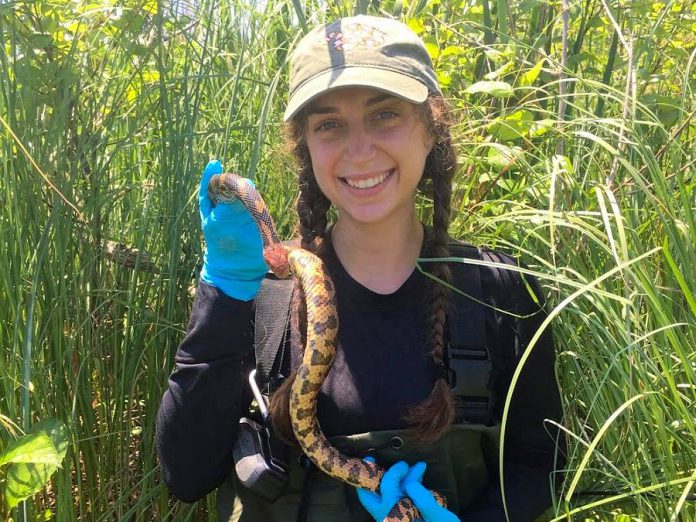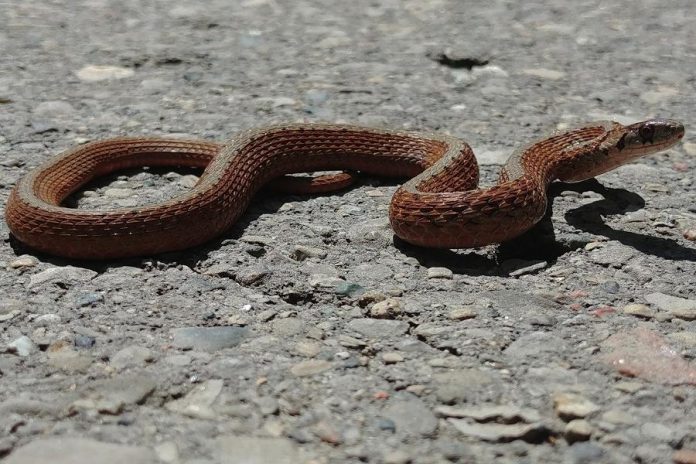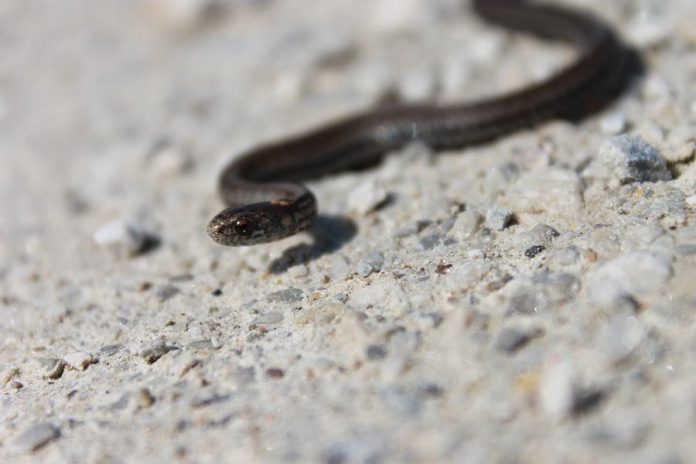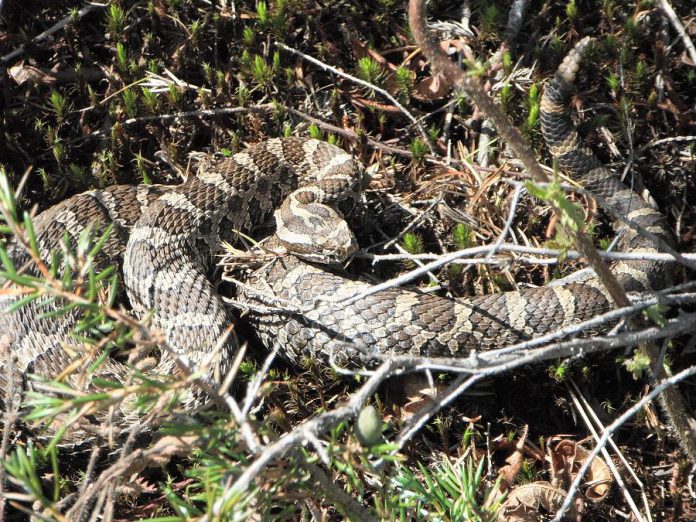
How would you react if you saw a water snake swimming alongside you in open water? Would you shriek in alarm and scramble to shore, or marvel at the snake’s athleticism?
Canadians biggest fear in 2015 was of snakes, beating out things like heights and public speaking according to a fundraising initiative launched by the Canadian Cancer society called the Fearless Challenge.
It found that 40 per cent of all Canadians were afraid of snakes.
But why? Many of us know that some of our fears are irrational and like many things they persist if left unchallenged.
“In Ontario, there is no need to fear our snakes for the same reason that someone in, let’s say Australia or India, might fear snakes,” says Rachel Dillon, who recently completed a Masters of Science in environmental and life sciences at Trent University. “We only have one venomous species of snake and our other 16 species of snake are harmless to humans.”
In other words, the risk of harm from snakes in Ontario is very low. The massasauga rattlesnake is the only venomous species in the province, and their population is considered at risk both provincially and federally. There have only been two recorded deaths caused by a massasauga rattlesnake bite in the province and neither of them occurred in the last 50 years, according to the Government of Ontario.
Knowing this helps put the level of risk snakes present in Ontario into perspective, something that’s commonly part of overcoming fears. While these steps might not help everyone, these three things helped me overcome my fear of snakes.
1. Expose yourself to snakes in a safe and supportive environment

For me, this meant interacting with a milk snake at Science North in Sudbury. I first watched another person holding the snake from a distance. Then, I was able to get closer to the snake and eventually touch her. (Snakes aren’t slimy, by the way; they’re scaly.)
Next, I worked up my courage to allow the snake to slither onto me until I was comfortable holding her. If you are afraid of snakes but want your kids to be comfortable with them, I recommend allowing them to interact with snakes in a safe and supervised environment.
While the Indian River Reptile Zoo is not currently allowing visitors into their snake exhibits due to COVID-19, this is a welcoming local spot to go with your family to see snakes in a fun, non-threatening way. In the meantime, you can support Indian River Reptile Zoo by enjoying the drive-through dinosaur park.
2. Learn more about snakes

Snakes, including massasauga rattlesnakes, are crucial to healthy ecosystems because they help control rodent populations that can otherwise damage crops and spread disease.
Snakes also serve as important food sources for other predators like hawks and foxes.
Learning how to identify the different species that we have in Ontario, including the massasauga rattlesnake, can help you develop a respect and appreciation for these reptiles. You may even start to say they’re cool!
You can learn more about the snakes of Ontario through the online Reptile and Amphibian Atlas on Ontario Nature’s website.

Did you know the eastern hog-nosed snake, which is listed as threatened in Ontario, can grow up to one metre long? It has a unique upturned or “hog-nosed” snout and can flatten out its neck to look like a cobra when it feels threatened.
While this display may appear terrifying to some, this non-venomous snake does it all for show. If you do get bitten by a non-venomous snake, wash the bite area with soap and water, check your immunization status, and get a tetanus shot if you are not up to date.
3. Dress and act responsibly to avoid snake bites

When out in natural areas hiking or camping, always wear sturdy closed-toed footwear and long pants. Be sure to stay on maintained trails as this will help minimize the chances that you’ll encounter snakes.
If you do encounter a snake, Dillon reminds us that “just like all wild animals, we should respect snakes and give them their space.”
Now that you understand the things that helped me overcome my fear of snakes, let’s learn a little more about Ontario’s only venomous snake species.
The massasauga rattlesnake is a threatened species in Ontario

The massasauga rattlesnake is a thick-bodied snake that grows 50 to 70 centimetres (19 to 27 inches) long and has a rattle at the end of its tail. Its head is triangular shaped and it has a grey to dark brown body with darker brown splotches down its back and sides. It is the only Ontario snake whose eyes contain a vertical pupil, similar to the eyes of a cat.
This unique snake has two known populations within the province. They can be found near Georgian Bay and the Bruce Peninsula in the Great Lakes-St. Lawrence region, and in the Carolinian region near Windsor.
Massasaugas were once more widespread in Ontario but persecution by humans, road mortality, and loss of habitat have reduced their numbers. Eight other species of snake are considered at risk in Ontario, having faced similar threats to their survival.
VIDEO: The Science in Saving the Massasauga Rattlesnake
Massasaugas are shy and prefer to avoid humans. If scared, the snake may shake its tail, which makes a distinct rattling sound. It does this to ward off potential predators, so if you do encounter one and hear the rattle, give the snake some space.
If you get too close and ignore the rattle, a massasauga may bite. Ontario Poison Control recommends that you remain calm if you are bitten by a massasauga rattlesnake as they don’t always release their venom. It’s best to call 911 and ask for an ambulance to the hospital as antivenom medicine is available in Ontario.
Keep in mind that the species is protected by the Ontario Endangered Species Act and the Canadian Species At Risk Act and it is illegal to harm or kill them.
Snakes are important for a healthy ecosystem
Of Ontario’s 17 species of snakes, nine of them are considered at risk of extinction.
The next time you see a snake, remember that it is performing an important role by eating rodents and keeping rodent populations in check.
Snakes are important for a healthy ecosystem and it is always best to let them be.
Please note: the steps above should not be taken in place of medical or psychological advice. These are meant to help overcome surface-level fears and should be explored on that basis.


























